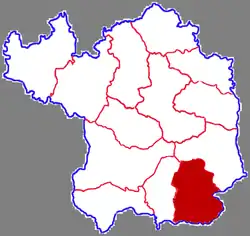Huanglong County
Huanglong County (simplified Chinese: 黄龙县; traditional Chinese: 黃龍縣; pinyin: Huánglóng Xiàn; lit. 'yellow dragon') is a county of Yan'an, Shaanxi Province, China.[1] Located in Northern Shaanxi, bordering Shanxi province to the east across the Yellow River, Huanglong County has an area of 2,751 square kilometers, and a permanent population of 49,500 as of 2012.[1]
Huanglong
黄龙县 | |
|---|---|
 Huanglong in Yan'an | |
.png.webp) Yan'an in Shaanxi | |
| Coordinates (Huanglong County People's Government): 35°35′05″N 109°50′25″E | |
| Country | People's Republic of China |
| Province | Shaanxi |
| Prefecture-level city | Yan'an |
| Area | |
| • Total | 2,751 km2 (1,062 sq mi) |
| Population (2012) | 49,500 |
| Time zone | UTC+8 (China standard time) |
| Postal code | 715700 |
Administrative divisions
The county is divided into 5 towns and 2 townships.[1] Huanglong County's five towns are Shibao, Baimatan, Wazijie, Jietoumiao, and Sancha.[1] Huanglong County's two townships are Getai Township and Yaoxian Township.[1] The county's government offices are located in Shibao Town.[1]
Geography
Huanglong County is located approximately 221 kilometers from Yan'an's urban core, and 226 kilometers from Xi'an's urban core.[1] Located in the Loess Plateau, Huanglong County is hilly in elevation, ranging from 643.7 to 1,738 meters in height.[1] A number of minor rivers run through the county.[1] 87% of Huanglong County is forested, and the county is home to 1,012 species of plants and 225 species of animals.[2]
Climate
The area experiences an average annual rainfall of 602.7 millimeters, and an average annual temperature of 8.6 °C.[1]
History
A human skull fossil dating 50,000 years old was uncovered in the county.[1][2] Other major archaeological digs include a number of Yangshao relics, dating back to the Neolithic Age.[1][2] A number of preserved historic sites dot the county, such as stone carvings and grottoes from the Tang and Song Dynasties, ancient tombs from the Qin, Han, Ming, and Qing Dynasties, as well as a number of sites relevant to the Chinese Civil War.[1]
Demographics
| Year | Pop. | ±% p.a. |
|---|---|---|
| 1947 | 34,587 | — |
| 1977 | 55,700 | +1.60% |
| 1990 | 45,664 | −1.52% |
| 2000 | 49,990 | +0.91% |
| 2003 | 46,996 | −2.04% |
| 2012 | 49,500 | +0.58% |
Huanglong County's population demonstrated consistent growth from the 1940s through the 1970s, but has since been somewhat stable due to sizable migration towards more urban areas.[3] The county is almost entirely Han Chinese in ethnicity, but is home to 11 minority groups.[3] As of 2000, its second largest ethnic group is the Hui People, with 76 people; the county's third largest ethnic group is the Mongol People, with 67 people.[3]
Economy
Well-known products from Huanglong County include its walnuts, honey, and Chinese mitten crabs.[2] The county has a walnut growing area 280,000 mu, yielding an annual output of 11,000 tons of walnuts.[2] The county has an apple growing area of 144,000 mu, producing 65,000 tons of apples annually.[2] There are 88,000 beehives in the county, producing 1,300 tons of honey annually.[2] The county also has 430 mu of crab farms.[2]
Transportation
The G22 Qingdao-Lanzhou Expressway passes through the county, as well as the Yu-Lan Expressway, and another highway to neighboring Hancheng City.[2]
References
- 黄龙县概况地图_行政区划网(区划地名网) www.xzqh.org. xzqh.org (in Chinese). 2015-06-30. Retrieved 2020-05-13.
- 黄龙概况 (in Chinese). Huanglong County People's Government. 2018-10-18. Archived from the original on 2019-01-26. Retrieved 2020-05-13.
- 黄龙人口 (in Chinese). Huanglong County People's Government. 2017-11-21. Archived from the original on 2019-01-25. Retrieved 2020-05-13.